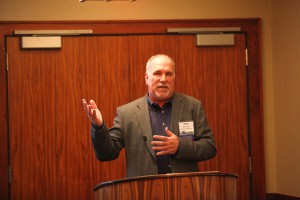New Jersey Future Blog
Forum Feature: Eyes Wide Open … or Shut
April 3rd, 2014 by David Kutner
New Jersey is paying insufficient attention to the increasing risks of a changing climate, and both good leadership and good information are needed if that is to change.
Speakers at a Redevelopment Forum session on climate risks were clear: We have failed to confront the risks that a changing climate poses for our future. Myths and misperceptions cloud our ability to address New Jersey’s growing vulnerability to increasingly frequent and severe storm and flooding events. Mark Mauriello, former commissioner of the New Jersey Dept. of Environmental Protection, who moderated the session, listed his “favorite” such myths:
- It’s never flooded here so it never will.
- If flooding were a problem someone would have told me about it.
- We just had a 100-year flood so we’re safe from future floods for the next 100 years.
- There was a flooding problem but it’s been fixed.
Mauriello suggested that an examination of 100 years of flood history clearly illustrates our vulnerability. We may not be able to tell when flooding will occur but we can certainly predict where it will occur. And we also know that it’s almost impossible to “fix” a flooding problem. We have sound land-use management techniques that can integrate climate risks into decision-making and influence where and how we build. But until the state makes these standards mandatory, he said, homeowners and developers will continue to build to the minimum requirements. And until the state takes the lead, municipalities are simply not equipped to go it alone.
The banking and insurance industries have considerable interest in vulnerability and risk. According to Bill Lashbrook, senior vice president for real estate at PNC Financial Services Group, insurance companies are well aware that climate events will continue to occur, and they have very accurate information about flood vulnerability. They know it’s economically infeasible to subsidize insurance to protect (and in some cases encourage) development in risky areas. Eventually, said Lashbrook, flood insurance must become “claims-based” – i.e., premiums are based entirely on claims history rather than being subsidized, as they are currently.
However, he acknowledged that such a change will have significant negative effects on property values: When property in flood-prone areas is transferred, sales prices will decline steeply if buyers have to pay elevated insurance premiums. Lashbrook noted that many homes on Jersey shore have been passed down within families for generations, and while they have sentimental value to their owners, they have lost a lot of market value because of their vulnerability. Lashbrook’s solution: a small – one-half of one percent – surcharge on every property casualty insurance policy in the state. Insurance companies would collect the money and send it to the state for deposit into a pool to be used for acquisition of property in flood-prone areas. Life estates would be granted after acquisition to allow the current owners to continue to occupy the houses, but the property would revert to the state when the current occupants vacated.
Also, Lashbrook said, requiring everyone in flood-prone areas to pay the full, unsubsidized cost of flood insurance as a condition of a mortgage will help educate people on the true costs of risk. He stressed that the public must be informed of these costs to enable them to make financially literate real-estate acquisition decisions.
John Miller, the legislative committee chairman of the New Jersey Association for Floodplain Management, remarked that there have been 11 presidential disaster declarations in New Jersey in the past nine years, and the state is no. 3 in the nation in flood insurance claims. Miller noted that although Congress has elected to roll back Biggert-Waters – the recent legislation increasing flood insurance premiums to reflect actual risk – such legislation is ultimately what is needed. Sea levels are rising, risk is increasing and New Jersey needs to evaluate land-use patterns accordingly, he said. Some areas are just too risky to build in.
Noting that FEMA’s base flood elevations are not forward-looking enough, Ann Holtzman, Hoboken’s zoning officer and flood plain administrator, discussed the city’s ambitious plan to incorporate the risks of seal level rise into its zoning, development and building codes, engineering, capital budgeting strategies, design standards, strategic planning and post-Sandy recovery plan. She had valuable tips for municipalities contemplating similar efforts: Avoid making big changes during election season, re-district to assure that all governing-body members have constituents in flood hazard areas, enlist early adopters and local residents who’ve suffered property damage to lead the charge, and don’t give up!


















Has Mr. Lashbrook crunched the numbers to support his proposal?
Is the analysis published somewhere?
Sounds interesting – especially as a first step in the “strategic retreat” discussion.